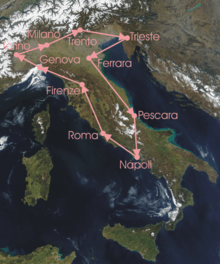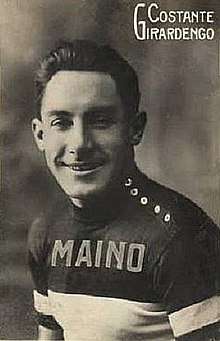1919 Giro d'Italia
The 1919 Giro d'Italia was the 7th edition of the Giro d'Italia, a cycling race organized and sponsored by the newspaper La Gazzetta dello Sport. The race began on 21 May in Milan with a stage that stretched 302.8 km (188 mi) to Trento, finishing back in Milan on 8 June after a 277 km (172 mi) stage and a total distance covered of 2,984 km (1,854 mi). The race was won by the Italian rider Costante Girardengo of the Stucchi team. Second and third respectively were Italian Gaetano Belloni and Belgian Marcel Buysse.
 Race Route | |||||||||||||||||||||
| Race details | |||||||||||||||||||||
|---|---|---|---|---|---|---|---|---|---|---|---|---|---|---|---|---|---|---|---|---|---|
| Dates | 21 May – 8 June | ||||||||||||||||||||
| Stages | 10 | ||||||||||||||||||||
| Distance | 2,984 km (1,854 mi) | ||||||||||||||||||||
| Winning time | 112h 51' 29" | ||||||||||||||||||||
| Results | |||||||||||||||||||||
| |||||||||||||||||||||
Of 66 riders starting the race, only 15 completed it. The Giro (the first one after the Great War) had the first to stages arriving in the "unredeemed" cities of Trento and Trieste, and was literally dominated by Girardengo, who won seven stages. The '"eternal second" Gaetano Belloni won his first stage in the Giro.
This edition of the race was also characterised by the first stage victory by a Swiss rider and by the first non-Italian cyclist on the final podium: the Belgian Marcel Buysse.
Participants
Of the 63 riders that began the Giro d'Italia on 21 May, fifteen of them made it to the finish in Milan on 8 June.[1] Riders were allowed to ride on their own or as a member of a team. There were four teams that competed in the race: Bianchi Pirelli, Legnano-Pirelli, Peugeot-Tedeschi, and Stucchi-Dunlop.[1] The isolati riders that participated in the race were primarily war veterans.[2] Organizers promised all isolati riders at least 180 lire if they reached Milan.[2] The Milan Army Corps carried participants luggage for the race with an Fiat 18 BL lorry that remained after the war.[2]
The peloton was almost completely composed of Italians.[1] The field featured two former Giro d'Italia champions in the three-time winner Carlo Galetti and Eberardo Pavesi who was a member of the 1912 Atala winning team.[1] Other notable Italian riders that started the race included Costante Girardengo, Angelo Gremo, Ezio Corlaita, and Giuseppe Santhià.[1] Girardengo was current Italian men's road race champion and was recovering from the Spanish flu.[2]
Final standings
Stage results
| Stage | Date | Course | Distance | Type[Notes 1] | Winner | Race Leader | |
|---|---|---|---|---|---|---|---|
| 1 | 21 May | Milan to Trento | 302.8 km (188 mi) | Stage with mountain(s) | |||
| 2 | 23 May | Trento to Trieste | 334.3 km (208 mi) | Stage with mountain(s) | |||
| 3 | 25 May | Trieste to Ferrara | 282 km (175 mi) | Plain stage | |||
| 4 | 27 May | Ferrara to Pescara | 411.2 km (256 mi) | Plain stage | |||
| 5 | 29 May | Pescara to Naples | 312.5 km (194 mi) | Stage with mountain(s) | |||
| 6 | 31 May | Naples to Rome | 203.8 km (127 mi) | Plain stage | |||
| 7 | 2 June | Rome to Florence | 350.8 km (218 mi) | Stage with mountain(s) | |||
| 8 | 4 June | Florence to Genoa | 261.8 km (163 mi) | Stage with mountain(s) | |||
| 9 | 6 June | Genoa to Turin | 248 km (154 mi) | Stage with mountain(s) | |||
| 10 | 8 June | Turin to Milan | 277 km (172 mi) | Plain stage | |||
| Total | 2,984 km (1,854 mi) | ||||||
General classification

There were fifteen cyclists who had completed all ten stages. For these cyclists, the times they had needed in each stage was added up for the general classification. The cyclist with the least accumulated time was the winner. Giosuè Lombardi won the prize for best ranked independent rider in the general classification.[4]
| Rank | Name | Team | Time |
|---|---|---|---|
| 1 | Stucchi-Dunlop | 112h 51' 29" | |
| 2 | Bianchi | + 51' 56" | |
| 3 | Bianchi | + 1h 05' 31" | |
| 4 | Stucchi-Dunlop | + 1h 34' 35" | |
| 5 | Bianchi | + 1h 39' 39" | |
| 6 | Stucchi-Dunlop | + 2h 20' 01" | |
| 7 | Stucchi-Dunlop | + 4h 12' 07" | |
| 8 | Maino | + 4h 16' 32" | |
| 9 | — | + 4h 28' 33" | |
| 10 | — | + 6h 03' 51" | |
| Final general classification (11–15)[1][5] | |||
|---|---|---|---|
| Rank | Name | Team | Time |
| 11 | Bianchi | + 6h 52' 54" | |
| 12 | Verdi | + 6h 53' 31" | |
| 13 | — | + 7h 15' 17" | |
| 14 | — | + 7h 57' 40" | |
| 15 | Verdi | + 9h 20' 59" | |
Points classification
There was a points based classification for the race.[6]
| Rank | Name | Team | Points |
|---|---|---|---|
| 1 | Stucchi-Dunlop | 21 | |
| 2 | Bianchi | 46 | |
| 3 | Bianchi | 62 | |
| 4 | Stucchi-Dunlop | 73 | |
| 5 | Stucchi-Dunlop | 78 | |
| 6 | Bianchi | 88 | |
| 7 | Stucchi-Dunlop | 9? | |
| 8 | Bianchi | 99 | |
| 9 | — | 119 | |
| Maino | |||
References
- Notes
- In 1919, there was no distinction in the rules between plain stages and mountain stages; the icons shown here indicate that the first, second, fifth, seventh, eighth, and ninth stages included major mountains.
- Citations
- Bill and Carol McGann. "1919 Giro d'Italia". Bike Race Info. Dog Ear Publishing. Retrieved 2012-07-10.
- "Special Editions: 1919". Giro d'Italia. La Gazzetta dello Sport. 2017. Archived from the original on 6 October 2019. Retrieved 12 May 2020.
- Barry Boyce. "Girardengo Untouchable". CyclingRevealed. CyclingRevealed. Retrieved 2012-07-10.
- "I vincitori delle categorie speciali" [The winners of the special categories]. Corriere dello Sport (in Italian). 14 June 1950. p. 6. Archived from the original on 22 December 2014. Retrieved 7 July 2013.
- "Giro d'Italia 1919". Cycling Archives. Retrieved 16 April 2013.
- "Girardengo vince il Giro d'Italia" [Girardengo wins the Tour of Italy]. La Stampa (in Italian). Editrice La Stampa. 9 June 1919. p. 4. Retrieved 27 May 2012.